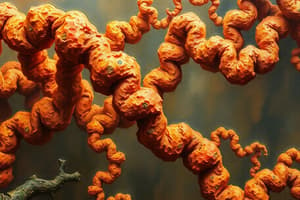Podcast
Questions and Answers
What structural feature is common to all proteins, regardless of their specific function?
What structural feature is common to all proteins, regardless of their specific function?
- Highly variable patterns of glycosylation
- Specific active sites for enzymatic activity
- Unique arrangement of disulfide bridges
- Repetitive polypeptide backbone (correct)
The sequence of amino acids in a protein's primary structure is determined by non-covalent interactions.
The sequence of amino acids in a protein's primary structure is determined by non-covalent interactions.
False (B)
What type of bond links amino acids together to form the primary structure of a protein?
What type of bond links amino acids together to form the primary structure of a protein?
peptide bond
In an α-helix, hydrogen bonds form between every ______ amino acid.
In an α-helix, hydrogen bonds form between every ______ amino acid.
Which of the following is NOT a characteristic of the polypeptide backbone shared by all proteins?
Which of the following is NOT a characteristic of the polypeptide backbone shared by all proteins?
A protein's function is primarily determined by its primary structure, making higher-order structures like secondary and tertiary structures less important.
A protein's function is primarily determined by its primary structure, making higher-order structures like secondary and tertiary structures less important.
What aspect of amino acids is most directly responsible for the diversity of protein structures and functions?
What aspect of amino acids is most directly responsible for the diversity of protein structures and functions?
Match the protein structure level with its description:
Match the protein structure level with its description:
Which type of secondary protein structure is characterized by a right-handed coil stabilized by hydrogen bonds between residues i and i+4?
Which type of secondary protein structure is characterized by a right-handed coil stabilized by hydrogen bonds between residues i and i+4?
Denaturation of a protein always results in irreversible loss of function.
Denaturation of a protein always results in irreversible loss of function.
Which level of protein structure directly determines the protein's specific function through interactions between amino acid side chains?
Which level of protein structure directly determines the protein's specific function through interactions between amino acid side chains?
What is the primary driving force that determines the final, functional conformation of a protein?
What is the primary driving force that determines the final, functional conformation of a protein?
The primary structure of a protein refers to the local folding patterns such as alpha-helices and beta-sheets.
The primary structure of a protein refers to the local folding patterns such as alpha-helices and beta-sheets.
Proteins are often measured in __________, with typical protein masses ranging from 10 kDa to hundreds of kDa.
Proteins are often measured in __________, with typical protein masses ranging from 10 kDa to hundreds of kDa.
Match the following terms with their correct descriptions:
Match the following terms with their correct descriptions:
What type of bond links the carboxyl group of one amino acid to the amino group of another, forming the polypeptide chain?
What type of bond links the carboxyl group of one amino acid to the amino group of another, forming the polypeptide chain?
Which of the following is common to all proteins?
Which of the following is common to all proteins?
The unique chemical group attached to the central carbon atom of each amino acid is known as the _____.
The unique chemical group attached to the central carbon atom of each amino acid is known as the _____.
Match the following protein structure levels with their descriptions:
Match the following protein structure levels with their descriptions:
The sequence differences in proteins do not affect the 3D folding.
The sequence differences in proteins do not affect the 3D folding.
What gives proteins their unique structures and functions?
What gives proteins their unique structures and functions?
Which of the following best describes the role of the quaternary structure in proteins?
Which of the following best describes the role of the quaternary structure in proteins?
Proteins are polymers of amino acids connected by __________ bonds.
Proteins are polymers of amino acids connected by __________ bonds.
Disulfide bridges are weak bonds that primarily stabilize the secondary structures of proteins.
Disulfide bridges are weak bonds that primarily stabilize the secondary structures of proteins.
Relate the correct Amino Acid notation.
Relate the correct Amino Acid notation.
What is the term for distinct functional or structural regions within a protein?
What is the term for distinct functional or structural regions within a protein?
Which amino acids are most favorable for alpha helix formation?
Which amino acids are most favorable for alpha helix formation?
The process by which a polypeptide chain achieves its functional 3D shape is known as _______.
The process by which a polypeptide chain achieves its functional 3D shape is known as _______.
What is the role of hydrogen bonds in the secondary structure of a protein?
What is the role of hydrogen bonds in the secondary structure of a protein?
Strands in parallel β-sheets run in opposite directions.
Strands in parallel β-sheets run in opposite directions.
What unit is used to measure Proteins?
What unit is used to measure Proteins?
Changing the primary structure of a protein will not affect its 3D structure or function.
Changing the primary structure of a protein will not affect its 3D structure or function.
What are the two common types of secondary structures found in proteins?
What are the two common types of secondary structures found in proteins?
The term __________ refers to the standard, typical, or widely accepted form of something in biology.
The term __________ refers to the standard, typical, or widely accepted form of something in biology.
In proteins, what is the approximate length scale that 1 nanometer equals?
In proteins, what is the approximate length scale that 1 nanometer equals?
The tetramer composed of four subunits that transports oxygen in the blood is called _______.
The tetramer composed of four subunits that transports oxygen in the blood is called _______.
Which of the following is NOT a component of every amino acid?
Which of the following is NOT a component of every amino acid?
Protein folding is a random process and is not influenced by the properties of amino acid side chains.
Protein folding is a random process and is not influenced by the properties of amino acid side chains.
Flashcards
Polypeptide Backbone
Polypeptide Backbone
A repetitive chain of amino acids linked by peptide bonds in all proteins.
Amino Acid Side Chains
Amino Acid Side Chains
Unique R groups attached to the polypeptide backbone that dictate protein structure and function.
Peptide Bond
Peptide Bond
A covalent bond formed between the carboxyl group of one amino acid and the amino group of another.
Primary Structure
Primary Structure
Signup and view all the flashcards
α-Helix
α-Helix
Signup and view all the flashcards
β-Sheet
β-Sheet
Signup and view all the flashcards
Functional Diversity of Proteins
Functional Diversity of Proteins
Signup and view all the flashcards
Protein Polymerization
Protein Polymerization
Signup and view all the flashcards
Tertiary Structure
Tertiary Structure
Signup and view all the flashcards
Quaternary Structure
Quaternary Structure
Signup and view all the flashcards
Secondary Structure
Secondary Structure
Signup and view all the flashcards
Side Chain (R Group)
Side Chain (R Group)
Signup and view all the flashcards
Hydrogen Bonds
Hydrogen Bonds
Signup and view all the flashcards
Domains
Domains
Signup and view all the flashcards
Folding
Folding
Signup and view all the flashcards
Disulfide Bridge
Disulfide Bridge
Signup and view all the flashcards
Polypeptide Chain
Polypeptide Chain
Signup and view all the flashcards
Amino Acids
Amino Acids
Signup and view all the flashcards
Functionality of Proteins
Functionality of Proteins
Signup and view all the flashcards
Enzymes
Enzymes
Signup and view all the flashcards
Parallel β-Sheet
Parallel β-Sheet
Signup and view all the flashcards
Antiparallel β-Sheet
Antiparallel β-Sheet
Signup and view all the flashcards
Random Coil
Random Coil
Signup and view all the flashcards
Denaturation
Denaturation
Signup and view all the flashcards
Dalton (Da)
Dalton (Da)
Signup and view all the flashcards
Kilodaltons (kDa)
Kilodaltons (kDa)
Signup and view all the flashcards
Energetically Favorable Conformation
Energetically Favorable Conformation
Signup and view all the flashcards
Mutation
Mutation
Signup and view all the flashcards
Hydrophobic Interaction
Hydrophobic Interaction
Signup and view all the flashcards
Hydrophilic Interaction
Hydrophilic Interaction
Signup and view all the flashcards
Canonical Sequence
Canonical Sequence
Signup and view all the flashcards
Domains in Proteins
Domains in Proteins
Signup and view all the flashcards
Study Notes
Protein Structure: Key Concepts
- All proteins share a common repetitive polypeptide backbone composed of amino acids linked by peptide bonds. This backbone structure provides consistency across proteins.
- The backbone is planar and rigid.
- Each amino acid has a unique side chain (R group). The different variations and sequences of these side chains enable proteins to have various shapes, interactions, and functions.
Protein Structure Hierarchy
- Primary Structure: The linear sequence of amino acids. A crucial aspect, as even slight changes dramatically affect shape and function. Example: Ser-Gly-Tyr-Ala-Leu (SGYAL).
- Secondary Structure: Local folding patterns stabilized by hydrogen bonds.
- α-Helix: A right-handed helix with hydrogen bonds between every fourth amino acid.
- β-Sheet: Strands arranged in parallel or antiparallel orientations, stabilized by hydrogen bonds. Example: α-helix fitting in DNA's major groove.
- Tertiary Structure: The overall 3D shape of a single polypeptide chain, formed by interactions of the side chains (hydrophobic interactions, ionic bonds, hydrogen bonds).
- Determines the protein's function by influencing how it interacts with other molecules. Example: Enzyme active sites.
- Quaternary Structure: The assembly of multiple polypeptide chains into a functional unit. Example: Hemoglobin, a tetramer for oxygen transport.
Amino Acids and Protein Building
- Amino acids: The building blocks of proteins. Each amino acid has a central carbon, an amino group, a carboxyl group, a hydrogen atom, and a unique side chain (R group). There are 20 canonical amino acids.
- Peptide bond: A covalent bond linking the carboxyl group of one amino acid to the amino group of another, forming the polypeptide chain. Partial double bond character makes it rigid and planar.
- Polypeptide chain: A sequence of amino acids linked by peptide bonds. Chains of 2-39 amino acids are called peptides, longer ones are proteins.
- Abbreviations: Three-letter and one-letter codes are used to simplify amino acid representation, including Alanine (Ala/A) and Tyrosine (Tyr/Y).
Protein Function and Structure
- Protein function: The protein's sequence (primary structure) dictates how it folds into its 3D form, ultimately determining the protein's specific function.
- Protein folding: Proteins fold into energetically favorable conformations driven by side chain properties to form distinct functional domains. Correct folding is essential for protein function.
- Denaturation: Unfolding or disruption of a protein's 3D structure, rendering it nonfunctional.
Definitions and Key Terms
- Protein A polymer made from amino acids, performing various bodily functions (enzymes, hormones, structure).
- Domain: A distinct functional or structural region within a protein.
- Disulfide bridge: A covalent bond between sulfur atoms of cysteine amino acids that stabilizes structure, especially extracellular proteins.
- Hydrogen bond: Weak bonds between oxygen and hydrogen in the polypeptide chain. Stabilizes secondary structures.
- Mutation: A change in the amino acid sequence. Even single mutations can impact protein folding and function, causing diseases (e.g., sickle cell anemia).
Additional Details
- Protein size measurement: Daltons (Da) measure protein mass (typically in kilodaltons, kDa).
- Energetically favorable conformation: The final, folded state of a protein; most stable and functional.
- Hydrophobic/Hydrophilic interactions: Determine protein folding. Hydrophobic side chains cluster together, while hydrophilic interact with water.
- Alpha Helix/Beta Sheet: Details on their structures and common occurrences within proteins.
- Canonical: Refers to the standard, most common, or widely accepted form of something. In proteins, the canonical structure refers to the established hierarchical organization and sequence as originally described.
Studying That Suits You
Use AI to generate personalized quizzes and flashcards to suit your learning preferences.




